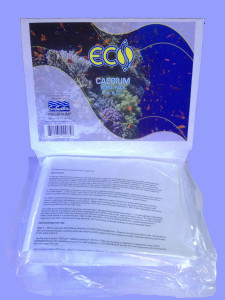ECO (Balling Method) CALCIUM 3-Part Supplement

BACKGROUND
Continued improvements in techniques, and advancements in aquarium technology, have made the successful maintenance and propagation of more and more corals in the reef aquarium a reality, and have necessitated the development of some type of effective dosing system to deliver elements vital to the well-being of many of these reef-building organisms, such as calcium and carbonates. In the early 1970s, a breakthrough in this area was made by German aquarist, Peter Wilkens, who advocated the use of calcium carbonated water in the aquarium. In his method, a saturated calcium hydroxide solution was “fed” into the aquarium, drop by drop, via a thin tube, but, this technique also caused a significant rise in pH.
In 1994, Ernst Pawlowsky, of Germany, introduced a new method of calcium supplementation, which soon became quite popular in the United States — Calcium part A and Calcium part B. At the same time, Rolf Hebbinghaus, of Germany, produced the calcium reactor, and Hans-Wermer Balling, also of Germany, developed the “Balling Method” of calcium supplementation.
By 1996, continued improvements to the Balling Method made it the method of choice for dosing reef aquariums, including calcium, magnesium and alkalinity, among others. When used correctly, all levels of major elements remain constant, with calcium levels at 420 mg/L, magnesium at about 1300 mg/L and carbonate alkalinity at 7 dKH. It also replenishes many of the minerals typically found in sea salt mixes.
According to numerous German aquarists who have been using the Balling Method (see Steps 1 – 5), although this methodology has accounted for a doubling in size of the small-polyped stony (SPS) corals in their aquariums within about 100 days, coloration has been compromised unless the following trace element supplements are also added (Step 6): Iodine, iron, strontium and NF Metal. What follows is a comprehensive, step by step, description of the ECO Ballling Method for supplementing calcium, magnesium and other minerals and trace elements, and maintaining carbonate alkalinity at natural seawater levels.
INSTRUCTIONS FOR USE:
Step 1 — Before using the ECO (Balling Method) CALCIUM 3-Part Supplement: Measure all vital parameters in the reef aquarium with commercial test kits, including carbonate alkalinity (dKH), calcium (Ca) and magnesium (Mg). Make the following adjustments (in the exact order) if…
…the Mg level is below 1300 ppm, adjust to a level of 1300 to 1400 ppm by using a magnesium supplement, such as ECO MAGNESIUM liquid (for established aquariums with livestock) or ECO MAGNESIUM powder (for new aquariums with no livestock). See instructions for use;
…the Ca level is below 400 ppm, adjust to a level of 420 to 430 ppm, by using a calcium supplement, such as ECO (Balling Method) CALCIUM C (for established aquariums with livestock) or ECO KALKWASSER and ECO CALCIUM plus (for new aquariums with no livestock). See instructions for use;
…the carbonate alkalinity level is below 7 dKH, adjust the carbonate alkalinity to 7.0 dKH using ECO (Balling Method) CALCIUM A (for established aquariums with livestock) or ECO BUFFER dKH (for new aquariums with no livestock). See instructions for use.
Note: Step 1 should be performed only once.
Step 2 — To maintain calcium (420–430 ppm), magnesium (1300–1400 ppm), dKH (7.0) and other important minerals at natural seawater levels:
Add 1 ounce (30 ml) per 30 U.S. gallons (50 ml/200 liters) of tank capacity (actual aquarium water volume) per day of each part of the ECO CALCIUM 3-Part Supplement (Parts A, B, and C) separately. The dosage may be varied, depending on the stony coral population.
Step 3 — Use a saturated calcium hydroxide solution at night, such as ECO KALKWASSER, to replace water lost to evaporation. Please see instructions for use.
Step 4 — Monitor carbonate alkalinity (dKH) weekly, as it tends to decrease due to heavy consumption of calcium carbonate by stony corals.
Step 5 — Do a regular, weekly water change and monitor the salinity (salt content) of the aquarium water, as the salt concentration tends to rise over time for various reasons, including evaporation; and finally,
Step 6 — Supplement weekly with ECO TRACE ELEMENTS (ECO IODINE, ECO IRON, ECO STRONTIUM, and ECO NF Metal). Please see instructions for use.
Enjoy your reefkeeping experience and watch the corals grow!
If you need help with writing an essay, you can employ a professional to write your essay. One of the main advantages of such a service is that you do not have to make a payment until the essay is done. The essay will be completed and checked for errors and plagiarism. bestcustomwriting.com The information will also be verified for precision. If you’re unhappy with the quality of your work, you can get a full refund. The services are offered at a reasonable cost and guarantee your satisfaction.



